2012学年高中英语语法大全汇总之形容词和副词
- 格式:doc
- 大小:108.00 KB
- 文档页数:10
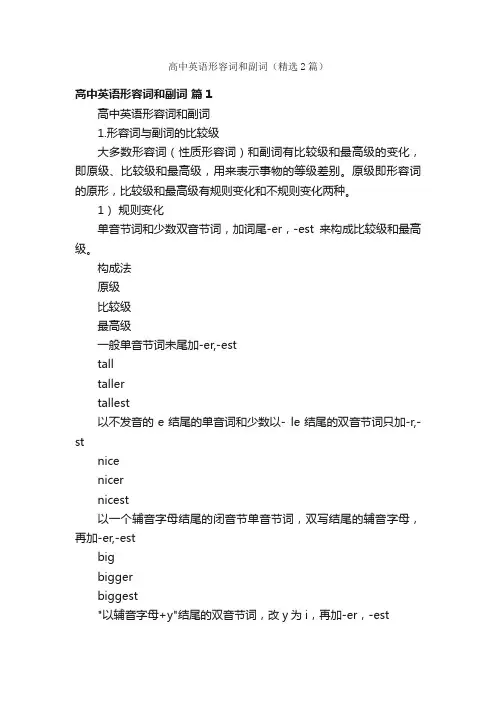
高中英语形容词和副词(精选2篇) 高中英语形容词和副词 篇1 高中英语形容词和副词 1.形容词与副词的比较级 大多数形容词(性质形容词)和副词有比较级和最高级的变化,即原级、比较级和最高级,用来表示事物的等级差别。原级即形容词的原形,比较级和最高级有规则变化和不规则变化两种。 1) 规则变化 单音节词和少数双音节词,加词尾-er,-est来构成比较级和最高级。 构成法 原级 比较级 最高级 一般单音节词未尾加-er,-est tall taller tallest 以不发音的e结尾的单音词和少数以- le结尾的双音节词只加-r,-st nice nicer nicest 以一个辅音字母结尾的闭音节单音节词,双写结尾的辅音字母,再加-er,-est big bigger biggest "以辅音字母+y"结尾的双音节词,改y为i,再加-er,-est busy busier busiest 少数以-er,-ow结尾的双音节词未尾加-er,-est clever/narrow cleverer/ narrower cleverest/ narrowest 其他双音节词和多音节词,在前面加more,most来构成比较级和最高级 important/ easily more important/ more easily most important/ most easily 2) 不规则变化 原级 比较级 最高级 good better best well(健康的) worse worst bad ill(有病的) old older/elder oldest/eldest much/many more most little less least far farther/further farthest/furthest 2.as + 形容词或副词原级 + as 1)在否定句或疑问句中可用so… as。 例如:he cannot run so/as fast as you. 他没你跑得快。 2)当as… as 中间有名词时采用以下格式: as +形容词+ a +单数名词 as + many/much +名词 例如:this is as good an example as the other is. 这个例子和另外一个一样好。 i can carry as much paper as you can. 你能搬多少纸,我也能。 3)用表示倍数的词或其他程度副词做修饰语时,放在as的前面。 例如:this room is twice as big as that one. 这房间的面积是那间的两倍。 your room is the same size as mine. 你的房间和我的一样大。 4)倍数+ as + adj. + as <=> 倍数+ the … + of。 例如:this bridge is three times as long as that one. 这座桥的长度是那座的三倍。 = this bridge is three times the length of that one. 3. 比较级形容词或副词 + than 。 例如: you are taller than i. 你比我高。 they lights in your room are brighter than those in mine.你房间的那些灯比我房间里的亮。 注意: 1)要避免重复使用比较级。 (错) he is more cleverer than his brother. (对) he is more clever than his brother. (对) he is clever than his brother. 2)要避免将主语含在比较对象中。 (错) china is larger than any country in asia. (对) china is larger than any other countries in asia. 3)要注意对应句型,遵循前后一致的原则。 the population of shanghai is larger than that of beijing. it is easier to make a plan than to carry it out. 4)要注意定冠词在比较级中的使用。 比较:which is larger, canada or australia? which is the larger country, canada or australia? 4.可修饰比较级的词 1)a bit, a little, rather, much, far, by far, many, a lot, lots, a great deal, any, still, even等。 2)还可以用表示倍数的词或度量名词作修饰语。 3)以上词(除by far)外,必须置于比较级形容词或副词的前面。 高中英语形容词和副词 篇2 高中英语形容词和副词 一.概念 形容词是用来修饰,描述名词或代词的词,主要用作定语,表语和补足语等. 副词是用来修饰动词,形容词,其化副词,介词短语或全句的词. 1.形容词及其用法 1)直接说明事物的性质或特征的形容词是性质形容词,它有级的变化,可以用程度副词修饰,在句中可作定语、表语和补语。 例如:the song sound beautiful. a beautiful girl 2)叙述形容词只能作表语,所以又称为表语形容词。这类形容词没有级的变化,也不可用程度副词修饰。大多数以a开头的形容词都属于这一类。例如:afraid 害怕的。这类词还有: well,unwell,ill,faint,afraid,alike,alive,alone,asleep,awake 等。 3)形容词作定语修饰名词时,要放在名词的前边。但是如果形容词修饰以-thing为字尾的词语时,要放在这些词之后。 例如:something nice. 2.以-ly结尾的形容词 1) 大部分形容词加-ly可构成副词。但 friendly,deadly,lovely,lonely,likely,lively,ugly,brotherly,仍为形容词。 例如:her singing was lovely. he spoke to me in a very friendly way. 2)有些以-ly 结尾既为形容词,也为副词,如daily,weekly,monthly,yearly,early等。 例如:the times is a weekly paper. 《时代周刊》为周刊。 the times is published weekly. 《时代周刊》每周发行一期。 3.用形容词表示类别和整体 1) 某些形容词加上定冠词可以泛指一类人,与谓语动词的复数连接,如the dead,the living,the rich,the poor,the blind,the hungry等。 例如:the poor are losing hope. 穷人行将失去希望。 2) 有关国家和民族的形容词加上定冠词指这个民族的整体,与动词的复数连用,如the british,the english,the french,the chinese等。 例如:the english have wonderful sense of humor. 英国人颇有幽默感。 4. 多个形容词修饰名词的顺序 多个形容词修饰名词时,其顺序为:限定词--数词--描绘词--(大小,长短,形状,新旧,颜色)--出处--材料性质--类别--名词。 例如:a beautiful little red flower 一朵美丽的小花。 i have a big, round, red, wooden, chinese table. 我有一个中国制造木制红色的大的园桌子。 练一练: 1 one day they crossed the ____bridge behind the palace. a. old chinese stone b. chinese old stone c. old stone chinese d. chinese stone old 2---- how was your recent visit to qingdao? ---- it was great. we visited some friends,and spent the ___days at the seaside. a. few last sunny b. last few sunny c. last sunny few d. few sunny last 5.副词的位置 1) 在动词之前。 2) 在be动词、助动词之后。 3) 多个助动词时,副词一般放在第一个助动词后。 注意: a. 大多数方式副词位于句尾,但宾语过长,副词可以提前,以使句子平衡。 例如:we could see very clearly a strange light ahead of us.我们清楚地看到前面有奇怪的光。 b. 方式副词well,badly,hard等只放在句尾。 例如:he speaks english well. 他英语说得好。 6.副词的排列顺序: 1) 时间,地点副词,小单位的在前,大单位在后。 2) 方式副词,短的在前,长的在后,并用and或but等连词连接。 例如:please write slowly and carefully. 请写得慢一些,仔细一些 3) 多个不同副词排列:程度+地点+方式+时间副词。 注意:副词very 可以修饰形容词,但不能修饰动词。 改错:(错) i very like english. (对) i like english very much. 注意:副词enough要放在形容词的后面,形容词enough放在名词前后都可。
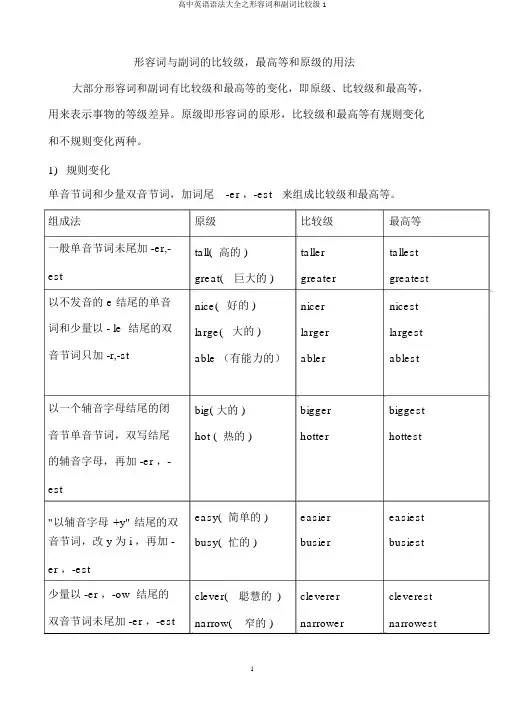
形容词与副词的比较级,最高等和原级的用法大部分形容词和副词有比较级和最高等的变化,即原级、比较级和最高等,用来表示事物的等级差异。
原级即形容词的原形,比较级和最高等有规则变化和不规则变化两种。
1)规则变化单音节词和少量双音节词,加词尾-er ,-est来组成比较级和最高等。
组成法原级比较级最高等一般单音节词未尾加 -er,-est以不发音的 e 结尾的单音词和少量以 - le 结尾的双音节词只加 -r,-st以一个辅音字母结尾的闭音节单音节词,双写结尾的辅音字母,再加 -er ,-est"以辅音字母+y" 结尾的双音节词,改 y 为 i ,再加 -er ,-est少量以 -er ,-ow 结尾的双音节词未尾加 -er ,-est tall( 高的 )taller tallest great(巨大的 )greater greatest nice(好的 )nicer nicest large(大的 )larger largest able (有能力的)abler ablestbig( 大的 )bigger biggest hot ( 热的 )hotter hottesteasy( 简单的 )easier easiest busy( 忙的 )busier busiestclever(聪慧的)cleverer cleverest narrow( 窄的 )narrower narrowest其余双音和多音,important( 重要more most在前面加 more ,most的)important important 来组成比和最高。
easily( 简单地 )more easily most easily 2) 不化原比最高good( 好的 )well(健康的 )better bestbad ( 坏的 )ill( 有病的 )worse worstold (老的 )older/elder oldest/eldestmuch/many( 多的 )more mostlittle(少的 )less leastfar (的 )farther/further farthest/furthest原比 : as+ 形容或副原 +as1 )在否认句或疑句中可用so ⋯ as 。
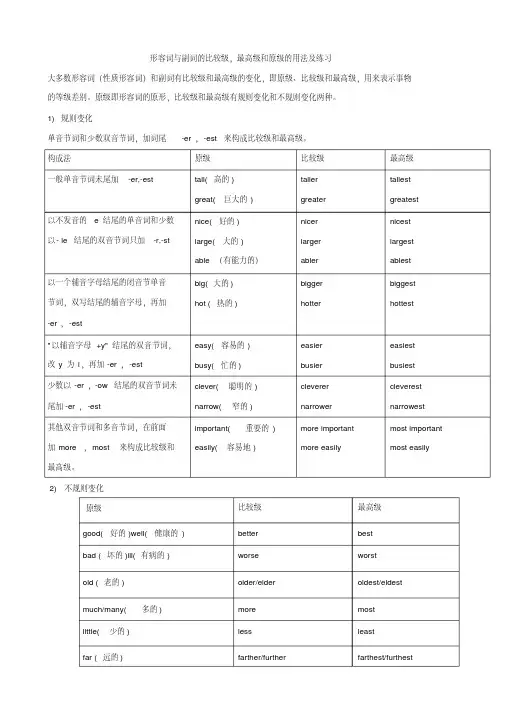
形容词与副词的比较级,最高级和原级的用法及练习大多数形容词(性质形容词)和副词有比较级和最高级的变化,即原级、比较级和最高级,用来表示事物的等级差别。
原级即形容词的原形,比较级和最高级有规则变化和不规则变化两种。
1) 规则变化单音节词和少数双音节词,加词尾-er,-est来构成比较级和最高级。
构成法原级比较级最高级一般单音节词未尾加-er,-est tall(高的)great(巨大的) tallergreatertallestgreatest以不发音的e结尾的单音词和少数以- le结尾的双音节词只加-r,-st nice(好的)large(大的)able(有能力的)nicerlargerablernicestlargestablest以一个辅音字母结尾的闭音节单音节词,双写结尾的辅音字母,再加-er,-est big(大的)hot (热的)biggerhotterbiggesthottest"以辅音字母+y"结尾的双音节词,改y为i,再加-er,-est easy(容易的)busy(忙的)easierbusiereasiestbusiest少数以-er,-ow结尾的双音节词未尾加-er,-est clever(聪明的)narrow(窄的)cleverernarrowercleverestnarrowest其他双音节词和多音节词,在前面加more,most来构成比较级和最高级。
important(重要的)easily(容易地)more importantmore easilymost importantmost easily2) 不规则变化原级比较级最高级good(好的)well(健康的) better bestbad (坏的)ill(有病的) worse worstold (老的) older/elder oldest/eldestmuch/many(多的) more mostlittle(少的) less leastfar (远的) farther/further farthest/furthest原级比较: as+形容词或副词原级+as1)在否定句或疑问句中可用so… as。
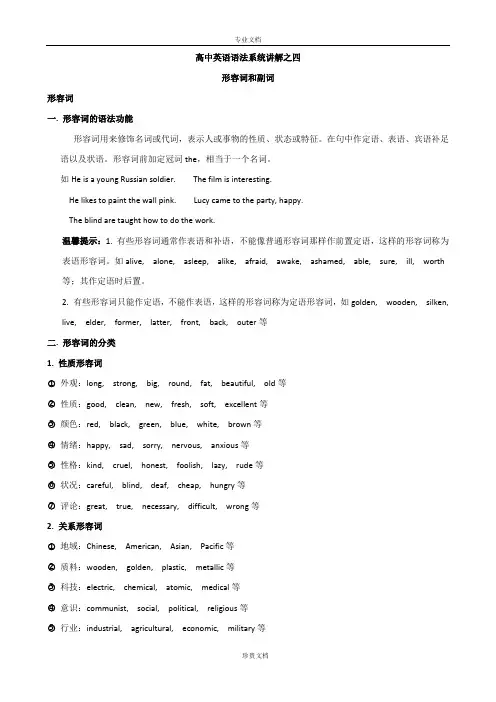
高中英语语法系统讲解之四形容词和副词形容词一. 形容词的语法功能形容词用来修饰名词或代词,表示人或事物的性质、状态或特征。
在句中作定语、表语、宾语补足语以及状语。
形容词前加定冠词the,相当于一个名词。
如He is a young Russian soldier. The film is interesting.He likes to paint the wall pink. Lucy came to the party, happy.The blind are taught how to do the work.温馨提示:1. 有些形容词通常作表语和补语,不能像普通形容词那样作前置定语,这样的形容词称为表语形容词。
如alive, alone, asleep, alike, afraid, awake, ashamed, able, sure, ill, worth 等;其作定语时后置。
2. 有些形容词只能作定语,不能作表语,这样的形容词称为定语形容词,如golden, wooden, silken,live, elder, former, latter, front, back, outer等二. 形容词的分类1. 性质形容词○1外观:long, strong, big, round, fat, beautiful, old等○2性质:good, clean, new, fresh, soft, excellent等○3颜色:red, black, green, blue, white, brown等○4情绪:happy, sad, sorry, nervous, anxious等○5性格:kind, cruel, honest, foolish, lazy, rude等○6状况:careful, blind, deaf, cheap, hungry等○7评论:great, true, necessary, difficult, wrong等2. 关系形容词○1地域:Chinese, American, Asian, Pacific等○2质料:wooden, golden, plastic, metallic等○3科技:electric, chemical, atomic, medical等○4意识:communist, social, political, religious等○5行业:industrial, agricultural, economic, military等三. 形容词在句中的位置1.单个形容词作定语时,一般放在被修饰的名词之前;两个或两个以上的形容词修饰一个名词时,同种类形容词的排列顺序一般应考虑以下两种情况:○1和被修饰的名词关系比较密切的形容词位置更靠近名词。

【高中英语】高中英语语法:形容词和副词【编者按】为您整理了英语语法,希望对广大考生朋友学习英语有一定的帮助!我的概念形容词是用来修饰,描述名词或代词的词,主要用作定语,表语和补足语等.副词是用来修饰动词、形容词、副词、介词、短语或整个句子的词二.相关知识点精讲1.形容词及其用法1)直接说明事物的性质或特征的形容词是性质形容词,它有级的变化,可以用程度副词修饰,在句中可作定语、表语和补语。
例如:hot。
2)叙述性形容词只能用作谓语,因此也被称为谓语形容词。
这种形容词没有等级变化,不能被程度副词修饰。
大多数以a开头的形容词都属于这一类。
例如:害怕就是害怕。
这类词还有:well,unwell,ill,faint,afraid,alike,alive,alone,asleep,awake等。
3)当形容词用作修饰名词的定语时,它们应该放在名词前面。
但如果形容词修饰以-thing结尾的词,请将它们放在这些词之后。
例如:美好的事物2.以-ly结尾的形容词1)大多数形容词加-ly可以构成副词。
但友好、死亡、爱、孤独、喜欢、活着、丑陋、兄弟,仍然是形容词。
改错:(错)shesanglovely.(错)他很友好地戳了戳(对)hersingingwaslovely.(对)他非常友好地戳了戳我2)有些以-ly结尾既为形容词,也为副词,如daily,weekly,monthly,yearly,early等。
例如:时间就像一张纸。
时代杂志是周刊。
thetimesispublishedweekly.《时代周刊》每周发行一期。
3.用形容词来表示类别和整体1)某些形容词加上定冠词可以泛指一类人,与谓语动词的复数连接,如thedead,theliving,therich,thepoor,theblind,thehungry等。
例如:这本书充满了希望。
穷人即将失去希望。
2)有关国家和民族的形容词加上定冠词指这个民族的整体,与动词的复数连用,如thebritish,theenglish,thefrench,thechinese等。
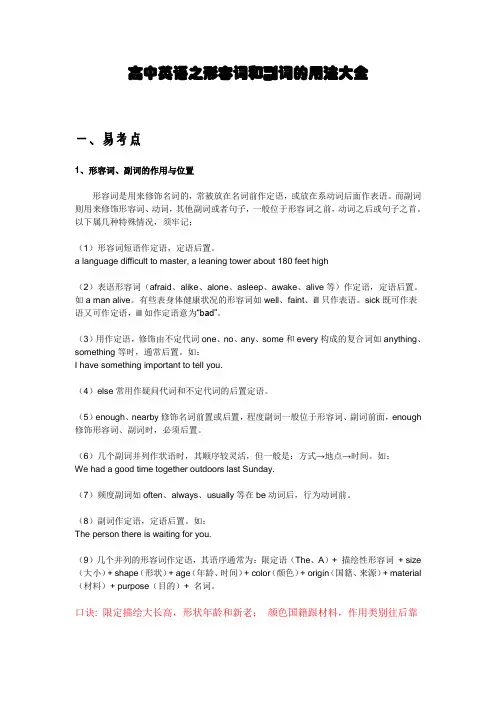
高中英语之形容词和副词的用法大全一、易考点1、形容词、副词的作用与位置形容词是用来修饰名词的,常被放在名词前作定语,或放在系动词后面作表语。
而副词则用来修饰形容词、动词,其他副词或者句子,一般位于形容词之前,动词之后或句子之首。
以下属几种特殊情况,须牢记;(1)形容词短语作定语,定语后置。
a language difficult to master, a leaning tower about 180 feet high(2)表语形容词(afraid、alike、alone、asleep、awake、alive等)作定语,定语后置。
如a man alive。
有些表身体健康状况的形容词如well、faint、ill只作表语。
sick既可作表语又可作定语,ill如作定语意为“bad”。
(3)用作定语,修饰由不定代词one、no、any、some和every构成的复合词如anything、something等时,通常后置。
如:I have something important to tell you.(4)else常用作疑问代词和不定代词的后置定语。
(5)enough、nearby修饰名词前置或后置,程度副词一般位于形容词、副词前面,enough 修饰形容词、副词时,必须后置。
(6)几个副词并列作状语时,其顺序较灵活,但一般是:方式→地点→时间。
如:We had a good time together outdoors last Sunday.(7)频度副词如often、always、usually等在be动词后,行为动词前。
(8)副词作定语,定语后置。
如:The person there is waiting for you.(9)几个并列的形容词作定语,其语序通常为:限定语(The、A)+ 描绘性形容词+ size (大小)+ shape(形状)+ age(年龄、时间)+ color(颜色)+ origin(国籍、来源)+ material (材料)+ purpose(目的)+ 名词。
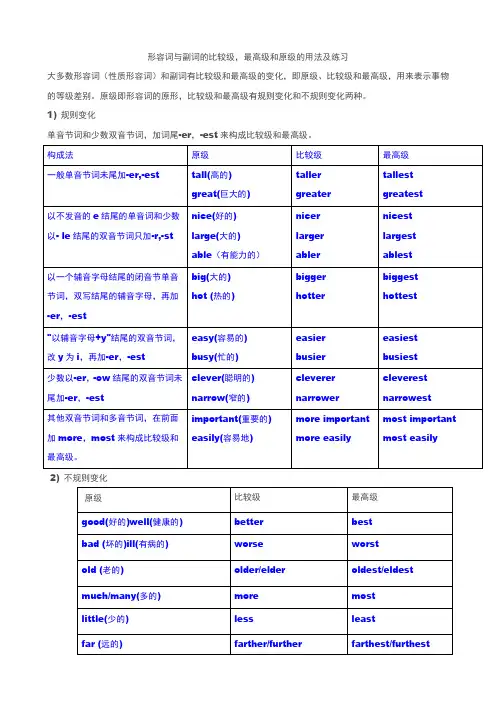
形容词与副词的比较级,最高级和原级的用法及练习大多数形容词(性质形容词)和副词有比较级和最高级的变化,即原级、比较级和最高级,用来表示事物的等级差别。
原级即形容词的原形,比较级和最高级有规则变化和不规则变化两种。
1) 规则变化单音节词和少数双音节词,加词尾-er,-est来构成比较级和最高级。
2) 不规则变化原级比较: as+形容词或副词原级+as1)在否定句或疑问句中可用so… as。
He cannot run so/as fast as you.2)当as… as 中间有名词时采用以下格式as +形容词+ a +单数名词\ as + many/much +名词This is as good an example as the other is.I can carry as much paper as you can..3)用表示倍数的词或其他程度副词做修饰语时,放在as的前面。
This room is twice as big as that one.Your room is the same size as mine.4)倍数表达法▲A is three(four, etc.)times the size(height, length etc.)of B.The new building is four times the size(the height)of the old one.这座新楼是那座旧楼的四倍大(高)/这座新楼比那座旧楼大(高)三倍。
▲A is three(four, etc.)times as big(high, long, etc.)as B.Asia is four times as large as Europe. 亚洲是欧洲的四倍大/亚洲比欧洲大三倍。
▲A is three (four, etc.)times bigger(higher, longer, etc.)than B.Your school is three times bigger than ours.你们的学校比我们的学校大三倍。
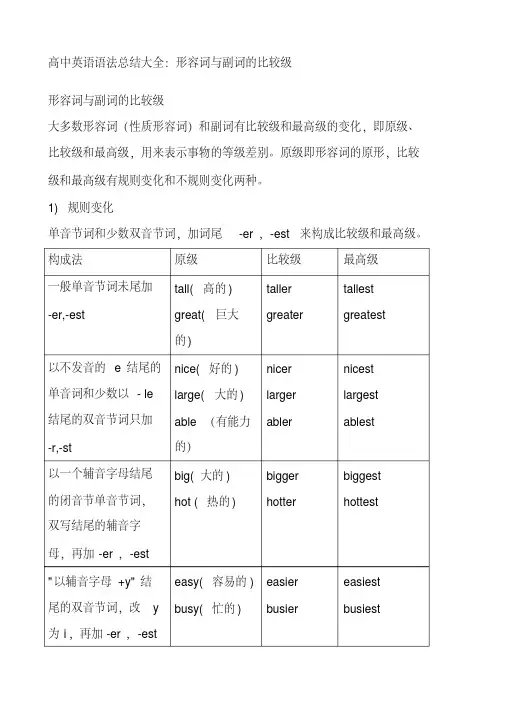
高中英语语法总结大全:形容词与副词的比较级形容词与副词的比较级大多数形容词(性质形容词)和副词有比较级和最高级的变化,即原级、比较级和最高级,用来表示事物的等级差别。
原级即形容词的原形,比较级和最高级有规则变化和不规则变化两种。
1) 规则变化单音节词和少数双音节词,加词尾-er,-est来构成比较级和最高级。
构成法原级比较级最高级一般单音节词未尾加-er,-est tall(高的)great(巨大的)tallergreatertallestgreatest以不发音的e结尾的单音词和少数以- le 结尾的双音节词只加-r,-st nice(好的)large(大的)able(有能力的)nicerlargerablernicestlargestablest以一个辅音字母结尾的闭音节单音节词,双写结尾的辅音字母,再加-er,-est big(大的)hot (热的)biggerhotterbiggesthottest"以辅音字母+y"结尾的双音节词,改y 为i,再加-er,-est easy(容易的)busy(忙的)easierbusiereasiestbusiest少数以-er,-ow结尾的双音节词未尾加-er,-est clever(聪明的)narrow(窄的)cleverernarrowercleverestnarrowest其他双音节词和多音节词,在前面加more,most来构成比较级和最高级。
important(重要的)easily(容易地)moreimportantmoreeasilymostimportantmost easily2) 不规则变化原级比较级最高级good(好的)well(健康的)better best bad (坏的)ill(有病的)worse worstold (老的) older/elder oldest/el destmuch/many(多的)more most little(少的) less leastfar (远的) farther/further farthest/ furthestas+形容词或副词原级+as1)在否定句或疑问句中可用so… as。
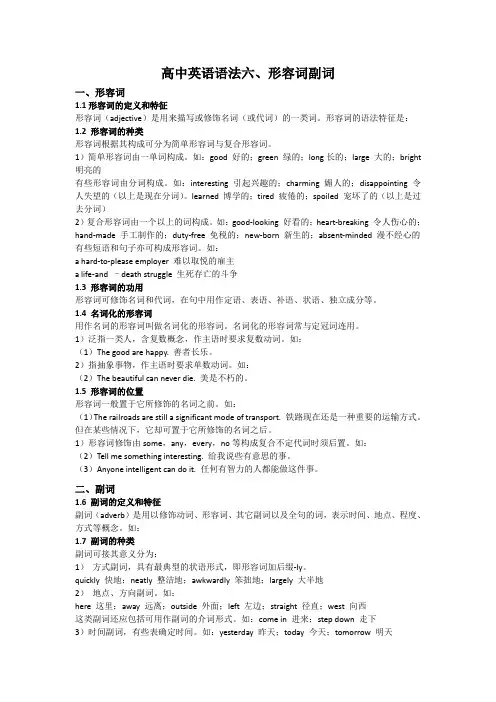
高中英语语法六、形容词副词一、形容词1.1形容词的定义和特征形容词(adjective)是用来描写或修饰名词(或代词)的一类词。
形容词的语法特征是:1.2 形容词的种类形容词根据其构成可分为简单形容词与复合形容词。
1)简单形容词由一单词构成。
如:good 好的;green 绿的;long长的;large 大的;bright 明亮的有些形容词由分词构成。
如:interesting 引起兴趣的;charming 媚人的;disappointing 令人失望的(以上是现在分词)。
learned 博学的;tired 疲倦的;spoiled 宠坏了的(以上是过去分词)2)复合形容词由一个以上的词构成。
如:good-looking 好看的;heart-breaking 令人伤心的;hand-made 手工制作的;duty-free 免税的;new-born 新生的;absent-minded 漫不经心的有些短语和句子亦可构成形容词。
如:a hard-to-please employer 难以取悦的雇主a life-and –death struggle 生死存亡的斗争1.3 形容词的功用形容词可修饰名词和代词,在句中用作定语、表语、补语、状语、独立成分等。
1.4 名词化的形容词用作名词的形容词叫做名词化的形容词。
名词化的形容词常与定冠词连用。
1)泛指一类人,含复数概念,作主语时要求复数动词。
如:(1)The good are happy. 善者长乐。
2)指抽象事物,作主语时要求单数动词。
如:(2)The beautiful can never die. 美是不朽的。
1.5 形容词的位置形容词一般置于它所修饰的名词之前。
如:(1)The railroads are still a significant mode of transport. 铁路现在还是一种重要的运输方式。
但在某些情况下,它却可置于它所修饰的名词之后。

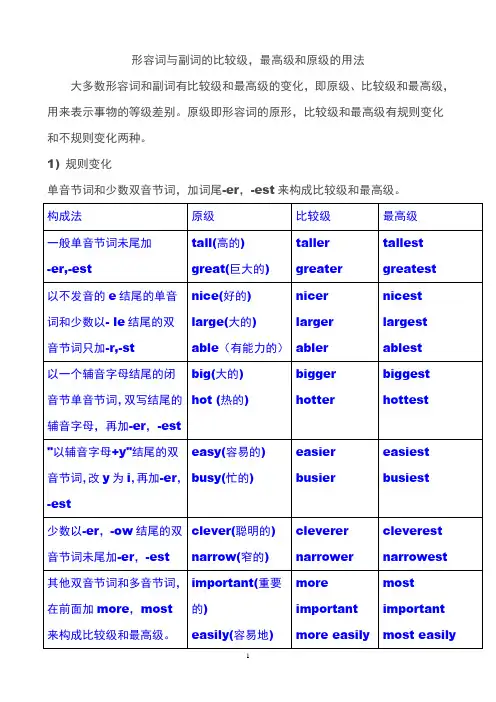
形容词与副词的比较级,最高级和原级的用法大多数形容词和副词有比较级和最高级的变化,即原级、比较级和最高级,用来表示事物的等级差别。
原级即形容词的原形,比较级和最高级有规则变化和不规则变化两种。
1) 规则变化单音节词和少数双音节词,加词尾-er,-est来构成比较级和最高级。
2) 不规则变化原级比较:as+形容词或副词原级+as1)在否定句或疑问句中可用so… as。
He cannot run so/as fast as you.2)当as… as 中间有名词时采用以下格式as +形容词+ a +单数名词\ as + many/much +名词This is as good an example as the other is.I can carry as much paper as you can..3)用表示倍数的词或其他程度副词做修饰语时,放在as的前面。
This room is twice as big as that one.Your room is the same size as mine.4)倍数表达法▲A is three(four, etc.)times the size(height, length etc.)of B.The new building is four times the size(the height)of the old one.这座新楼是那座旧楼的四倍大(高)/这座新楼比那座旧楼大(高)三倍。
▲A is three(four, etc.)times as big(high, long, etc.)as B.Asia is four times as large as Europe. 亚洲是欧洲的四倍大/亚洲比欧洲大三倍。
▲A is three (four, etc.)times bigger(higher, longer, etc.)than B.Your school is three times bigger than ours.你们的学校比我们的学校大三倍。
形容词与副词的比较级,最高级和原级的用法大多数形容词和副词有比较级和最高级的变化,即原级、比较级和最高级,用来表示事物的等级差别。
原级即形容词的原形,比较级和最高级有规则变化和不规则变化两种。
1) 规则变化单音节词和少数双音节词,加词尾-er,-est来构成比较级和最高级。
2) 不规则变化原级比较: as+形容词或副词原级+as1)在否定句或疑问句中可用so… as。
He cannot run so/as fast as you.2)当as… as 中间有名词时采用以下格式as +形容词+ a +单数名词\ as + many/much +名词This is as good an example as the other is.I can carry as much paper as you can..3)用表示倍数的词或其他程度副词做修饰语时,放在as的前面。
This room is twice as big as that one.Your room is the same size as mine.4)倍数表达法▲A is three(four, etc.)times the size(height, length etc.)of B.The new building is four times the size(the height)of the old one.这座新楼是那座旧楼的四倍大(高)/这座新楼比那座旧楼大(高)三倍。
▲A is three(four, etc.)times as big(high, long, etc.)as B.Asia is four times as large as Europe. 亚洲是欧洲的四倍大/亚洲比欧洲大三倍。
▲A is three (four, etc.)times bigger(higher, longer, etc.)than B.Your school is three times bigger than ours.你们的学校比我们的学校大三倍。
版权所有:中华资源库 www.ziyuanku.com 高中英语语法大全之形容词和副词 形容词及其用法 形容词修饰名词,说明事物或人的性质或特征。通常,可将形容词分成性质形容词和叙述形容词两类,其位置不一定都放在名词前面。 1)直接说明事物的性质或特征的形容词是性质形容词,它有级的变化,可以用程度副词修饰,在句中可作定语、表语和补语。例如:hot 热的。 2)叙述形容词只能作表语,所以又称为表语形容词。这类形容词没有级的变化,也不可用程度副词修饰。大多数以a开头的形容词都属于这一类。例如:afraid 害怕的。 (错)He is an ill man. (对)The man is ill. (错)She is an afraid girl. (对)The girl is afraid. 这类词还有: well,unwell,ill,faint,afraid,alike,alive,alone,asleep,awake 等。 3)形容词作定语修饰名词时,要放在名词的前边。但是如果形容词修饰以-thing为字尾的词语时,要放在这些词之后,例如: something nice
以-ly结尾的形容词 1) 大部分形容词加-ly可构成副词。但 friendly,deadly,lovely,lonely,likely,lively,ugly,brotherly,仍为形容词。 改错:(错) She sang lovely. (错) He spoke to me very friendly. (对) Her singing was lovely. (对) He spoke to me in a very friendly way. 2)有些以-ly 结尾既为形容词,也为副词。 daily,weekly,monthly,yearly,early The Times is a daily paper. The Times is published daily. 版权所有:中华资源库 www.ziyuanku.com
用形容词表示类别和整体 1) 某些形容词加上定冠词可以泛指一类人,与谓语动词的复数连接。如:the dead,the living,the rich,the poor,the blind,the hungry The poor are losing hope. 2) 有关国家和民族的形容词加上定冠词指这个民族的整体,与动词的复数连用。 the British,the English,the French,the Chinese. The English have wonderful sense of humor.
多个形容词修饰名词的顺序 多个形容词修饰名词时,其顺序为: 限定词--数词--描绘词--(大小,长短,形状,新旧,颜色) --出处--材料性质,类别--名词 a small round table a tall gray building a dirty old brown shirt a famous German medical school an expensive Japanese sports car 典型例题: 1) Tony is going camping with ___ boys. A.little two otherB. two little otherC.two other littleD.little other two 答案:C。由"限定词--数词--描绘词--(大小,长短,形状,新旧,颜色) --性质--名词"的公式可知数词,描绘词,性质依次顺序,只有C符合答案。 2)One day they crossed the ____bridge behind the palace. A. old Chinese stone B. Chinese old stoneC. old stone ChineseD. Chinese stone old 答案A. 几个形容词修饰一个名词,他们的排列顺序是:年龄,形状,大小+颜色+来源+质地+用途+国家+名词。 3) ---- How was your recent visit to Qingdao? ---- It was great. We visited some friends,and spent the ___days at the seaside. A. few last sunnyB. last few sunnyC. last sunny fewD. few sunny last 答案:B。本题考查多个形容词的排序问题。一般与被修饰形容词关系密切的形容词靠 版权所有:中华资源库 www.ziyuanku.com
近名词;如果几个形容词的重要性差不多,音节少的形容词在前,音节多的方在后,在不能确定时,可参照下表: 限定词+数量词(序数词在前,基数词在后)+性状形容词+大小、长短、高低等形体+ those + three + beautiful + large + square 新旧+颜色+国籍+材料+名词 old + brown + wood + table
副词及其基本用法 副词主要用来修饰动词,形容词,副词或其他结构。 一、副词的位置: 1) 在动词之前。 2) 在be动词、助动词之后。 3) 多个助动词时,副词一般放在第一个助动词后。 注意: a. 大多数方式副词位于句尾,但宾语过长,副词可以提前,以使句子平衡。 We could see very clearly a strange light ahead of us. b. 方式副词well,badly糟、坏,hard等只放在句尾。 He speaks English well. 二、副词的排列顺序: 1) 时间,地点副词,小单位的在前,大单位在后。 2) 方式副词,短的在前,长的在后,并用and或but等连词连接。 Please write slowly and carefully. 3) 多个不同副词排列:程度+地点+方式+时间副词。 注意:副词very 可以修饰形容词,但不能修饰动词。 改错:(错)I very like English. (对)I like English very much. 注意:副词enough要放在形容词的后面,形容词enough放在名词前后都可。 I don't know him well enough. There is enough food for everyone to eat. There is food enough for everyone to eat. 版权所有:中华资源库 www.ziyuanku.com
兼有两种形式的副词 1) close与closely close意思是"近"; closely 意思是"仔细地" He is sitting close to me. Watch him closely. 2)late 与lately late意思是"晚"; lately 意思是"最近" You have come too late. What have you been doing lately? 3)deep与deeply deep意思是"深",表示空间深度;deeply时常表示感情上的深度,"深深地" He pushed the stick deep into the mud. Even father was deeply moved by the film. 4)high与highly high表示空间高度;highly表示程度,相当于much The plane was flying high. I think highly of your opinion. 5)wide与widely wide表示空间宽度;widely意思是"广泛地","在许多地方" He opened the door wide. English is widely used in the world. 6)free与freely free的意思是"免费";freely 的意思是"无限制地" You can eat free in my restaurant whenever you like. You may speak freely; say what you like.
形容词与副词的比较级 大多数形容词(性质形容词)和副词有比较级和最高级的变化,即原级、比较级和最高级,用来表示事物的等级差别。原级即形容词的原形,比较级和最高级有规则变化和不规则 版权所有:中华资源库 www.ziyuanku.com
变化两种。 1) 规则变化 单音节词和少数双音节词,加词尾-er,-est来构成比较级和最高级。
构成法 原级 比较级 最高级 一般单音节词未尾加-er,-est tall(高的) great(巨大的) taller greater tallest
greatest 以不发音的e结尾的单音词和少数以- le结尾的双音节词只加-r,-st nice(好的) large(大的) able(有能力的)
nicer larger abler nicest largest ablest 以一个辅音字母结尾的闭音节单音节词,双写结尾的辅音字母,再加-er,-est big(大的) hot (热的) bigger hotter biggest
hottest
"以辅音字母+y"结尾的双音节词,改y为i,再加-er,-est easy(容易的) busy(忙的) easier busier easiest
busiest 少数以-er,-ow结尾的双音节词未尾加-er,-est clever(聪明的) narrow(窄的) cleverer narrower cleverest
narrowest 其他双音节词和多音节词,在前面加more,most来构成比较级和最高级。 important(重要的) easily(容易地)
more important more easily most important most easily
2) 不规则变化 原级 比较级 最高级 good(好的) well(健康的) better best
bad (坏的) ill(有病的) worse worst
old (老的) older/elder oldest/elde